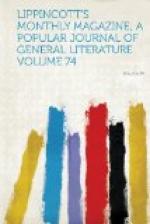And in fact, as we glided past, a little child was seen at a port-hole of the Michigan, waving a handkerchief to mamma on the Japan. It had been seriously ill, and the mother, forbidden by the United States government to remain with her sick child on the Michigan, preferred to leave him there with his father, where he could have the care of the special surgeon who understood the case, while she followed as closely as she could in one of the lake-steamers. Ah, how interested we all were! It is recorded in history that certain enemies of the Egyptians used to go into battle with them with each man holding a cat in his arms. Suppose in our next war we try the effect upon our enemies of letting each of our soldiers carry a white-robed baby? One thing is certain, the Michigan captured the Japan with all on board that day simply by exhibiting that little white figure at its port-hole. The next day at the “Soo” not a murmur of dissent was heard when the good-natured captain, who had no European mails on board, said he would wait an extra hour for the Michigan to come up, that the anxious mother might have twenty-four hours’ later news.
On the second morning there was an entire change of weather and landscape. The sun still shone gloriously (the thermometer that day in Chicago stood at 94), but rugs, seal-skins, and hoods were in demand. We were no longer out of sight of land, but were threading our way in and out among a thousand isles, with hills that seemed almost mountains threatening to bar our course before long if we did not turn back the way we came. No one, the captain said, had ever been known to guess the channel correctly; but before long we had made a sharp turn to the left at the only spot that offered an outlet, and found the Great Lakes narrowed suddenly to a beautiful winding river which led us in the course of another hour or two to the “Soo.” Here the steamer would wait three hours, and we could explore the queer little town,—quite a popular resort in summer,—or inspect the splendid locks of the great canal, or shoot the rapids. To me it was a genuine pleasure to find at last some rapids that were visible to the naked eye. The famous rapids of the St. Lawrence had been a severe disappointment, but here were rapids worthy of the name. Lake Superior was visibly above us, Lake Huron visibly below, and between ran the turbulent little stream which of course must be flowing into Lake Huron, though we could not have told merely by looking at it which way the current ran.
“Would we go up the rapids?” We had heard of going down the rapids, but in reality the most wonderful part of the performance is going up. Not only is the current fearfully swift, even close to the shore as it is necessary to keep, but the water seems to be only a few inches deep, and the rocks are as thick as plums in a Christmas pudding. Yet two Indians, standing erect, one in the bow and one in the stern of the canoe, pole you up the stream against these terrible odds as easily and surely as a Harvard oarsman might row you across Seneca Lake. Then they pause for a moment.




